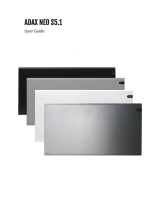
Table of contents
User reference guide
2
EHBH/X04+08+16CA + EHVH/X04+08+16CA
Daikin Altherma - Low Temperature Split
4P313778-1B – 2012.11
Table of contents
1
General safety precautions ..............................
2
1.1
About the documentation ..........................................................
2
1.1.1 Meaning of warnings and symbols ............................
2
1.2
For the user ..............................................................................
2
2
About this document ........................................
3
3
About the system ..............................................
3
3.1
Components in a typical system layout ....................................
3
4
Operation ...........................................................
3
4.1
Overview: Operation .................................................................
3
4.2
The user interface at a glance ..................................................
4
4.2.1 Buttons .......................................................................
4
4.2.2 Status icons ...............................................................
4
4.3
Basic usage ..............................................................................
5
4.3.1 Using home pages .....................................................
5
4.3.2 Using the menu structure ...........................................
5
4.3.3 Turning ON/OFF controls ..........................................
5
4.4
Space heating/cooling control ...................................................
5
4.4.1 About space heating/cooling control ..........................
5
4.4.2 Setting the space operation mode .............................
5
4.4.3 Controlling the temperature .......................................
6
4.5
Domestic hot water control .......................................................
10
4.5.1 About domestic hot water control ..............................
10
4.5.2 Reheat mode .............................................................
10
4.5.3 Scheduled mode ........................................................
10
4.5.4 Scheduled + reheat mode .........................................
11
4.5.5 Using the DHW tank temperature home page ...........
11
4.5.6 Using the DHW tank booster mode ...........................
12
4.6
Advanced usage .......................................................................
12
4.6.1 Using quiet mode .......................................................
12
4.6.2 Using holiday mode ...................................................
13
4.6.3 Reading out information .............................................
14
4.6.4 Configuring date, time, units of measurement,
contrast and backlight ................................................
14
4.6.5 Configuring user profile and home pages ..................
15
4.6.6 Locking and unlocking buttons and functions ............
15
4.7
Preset values and schedules ....................................................
15
4.7.1 Using preset values ...................................................
15
4.7.2 Using and programming schedules ...........................
16
4.7.3 Schedules: Example ..................................................
16
4.7.4 Predefined schedules: Room temperature + leaving
water temperature (main) ..........................................
17
4.7.5 Predefined schedules: Leaving water temperature
(additional) .................................................................
17
4.7.6 Predefined schedules: DHW tank temperature .........
18
4.8
Menu structure: Overview .........................................................
19
4.9
Installer settings: Tables to be filled in by installer ....................
20
4.9.1 Quick wizard ..............................................................
20
4.9.2 Space heating/cooling control ....................................
20
4.9.3 Domestic hot water control [A.4] ................................
20
4.9.4 Contact/helpdesk number [6.3.2] ...............................
20
5
Energy saving tips ............................................
20
6
Maintenance and service .................................
21
6.1
Overview: Maintenance and service .........................................
21
6.2
To find the contact/helpdesk number ........................................
21
7
Troubleshooting ................................................
21
7.1
Overview: Troubleshooting .......................................................
21
7.2
To check the error history .........................................................
21
7.3
Symptom: You are feeling too cold (hot) in your living room ....
21
7.4
Symptom: The water at the tap is too cold ...............................
21
8
Relocation ..........................................................
21
8.1
Overview: Relocation ................................................................
21
9
Disposal .............................................................
21
9.1
Overview: Disposal ...................................................................
21
10
Glossary .............................................................
22
1 General safety precautions
1.1 About the documentation
▪ The original documentation is written in English. All other
languages are translations.
▪ The precautions described in this document cover very important
topics, follow them carefully.
▪ All activities described in the installation manual must be
performed by an authorized installer.
1.1.1 Meaning of warnings and symbols
DANGER
Indicates a situation that results in death or serious injury.
DANGER: RISK OF ELECTROCUTION
Indicates a situation that could result in electrocution.
DANGER: RISK OF BURNING
Indicates a situation that could result in burning because of
extreme hot or cold temperatures.
WARNING
Indicates a situation that could result in death or serious
injury.
CAUTION
Indicates a situation that could result in minor or moderate
injury.
NOTICE
Indicates a situation that could result in equipment or
property damage.
INFORMATION
Indicates useful tips or additional information.
1.2 For the user
▪ If you are not sure how to operate the unit, contact your installer.
▪ The appliance is not intended for use by persons, including
children, with reduced physical, sensory or mental capabilities, or
lack of experience and knowledge, unless they have been given
supervision or instruction concerning use of the appliance by a
person responsible for their safety. Children must be supervised to
ensure that they do not play with the product.
CAUTION
Do NOT rinse the unit. This may cause electric shocks or
fire.
NOTICE
▪ Do NOT place any objects or equipment on top of the
unit.
▪ Do NOT sit, climb or stand on the unit.
▪ Units are marked with the following symbol:
This means that electrical and electronic products may not be
mixed with unsorted household waste. Do NOT try to dismantle
the system yourself: the dismantling of the system, treatment of
the refrigerant, of oil and of other parts must be done by an




















